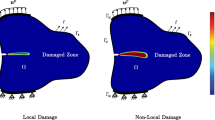Abstract
The problem of a radial or circumferential matrix crack interacting with a circular inclusion surrounded by an interphase region is investigated. The problem is formulated using Kolosov-Muskhelishvili complex potentials where the crack is modeled as a distribution of dislocations. The complex potentials for a dislocation interacting with a circular inclusion with an interphase are first rederived and then used in the crack formulation. The corresponding Cauchy singular integral equations are then solved using the Lobatto–Chebyshev quadrature technique. After comparing the current solution with previously published results, the influence of the interphase stiffness and thickness on a radial or circumferential matrix crack is studied for a glass fiber-epoxy composite. From this study it was found that compliant interphases increase the Mode I stress intensity factors for radial cracks while stiff interphases shield these cracks from the inclusion relative to the no-interphase cases. Additionally, the compliant interphases were found to be more affected by the thickness of the interphase. Results for the circumferential cracks were not as straightforward. Compliant interphases decreased the Mode II stress intensity factors but, depending on the interphase thickness and distance from the crack, could either shield or enhance the Mode I stress intensity factors. Stiff interphases increased the Mode II SIF but decreased the Mode I SIF as compared to the no-interphase cases.
Similar content being viewed by others
References
Achenbach, J.D. and Zhu, H. (1989). Effect of interfacial zone on mechanical behavior and failure of fiberreinforced composites. Journal of the Mechanics Physics Solids 37, 381–393.
Anlas, G. and Santare, M.H. (1993). A model for matrix cracking in short fiber composites. International Journal of Solids and Structures 30, 1701–1713.
Bechel, V.T. and Kaw, A.K. (1994). Fracture mechanics of composites with nonhomogeneous interphases and nondilute fiber volume fractions. International Journal of Solids and Structure 31, 2053–2070.
Chawla, K.K. (1997). Interfaces in metal matrix composites. Comp. Interfaces 4, 287–298.
Cheeseman, B.A. and Santare, M.H. (2000). The interaction of a curved crack with a circular inclusion International Journal of Fracture 103, 259–277.
Chen, Y.Z., Gross, D. and Huang, Y.J. (1991). Numerical solution of the curved crack problem by means of polynomial approximation of the dislocation distribution. Engineering Fracture of Mechanics 39, 791–797.
Herrmann, K.P., Noe, A. and M. Dong, M. (1996). Interfacial crack growth in thermomechanically loaded bimaterial joints. Composites A27, 813.
Hiemstra, D.L. and Sottos, N.R. (1993). Themally induced interfacial microcracking in polymer matrix composites. Journal Comp. Mat. 27, 1030–1051.
Hwu, C., Liang Y.K. and Yen, W.J. (1995). Interactions between inclusions and various types of cracks. International Journal of Fracture 73, 301–323.
Jayaraman, K., Gao, Z. and Reifsnider, K.L. (1994). The interphase in unidirectional fiber-reinforced epoxies: effect on local stress fields. Journal of Comp. Tech. Res. 16, 21.
Jayaraman, K., Reifsnider, K.L. and Swain, R.E. (1993a). Elastic and thermal effects in the interphase: Part I. Comments on characterization methods. Journal of Comp. Tech. Res. 15, 3–13.
Jayaraman, K., Reifsnider, K.L. and Swain, R.E. (1993b). Elastic and thermal effects in the interphase: Part II. Comments on modeling studies. Journal of Comp. Tech. Res. 15, 14–22.
Kaw, A.K. and Besterfield, G.H. (1991). Effect of interphases on mechanical behavior of composites. Journal of Engineering Mechanics 117, 2641–2657.
Kaw, A.K. and Das, V.G. (1991). Crack in an imperfect interface in composites. Mechanics Materials 11, 295–322.
Kaw, A.K., Sevarathinam, A.S. and Besterfield, G.H. (1992). Comparison of interphase models for a crack in fiber reinforced composite. Theory of Applied Fracture of Mechanics 17, 133–147.
Kerans, R.J., Hay, R.S., Pagano, N.J. and Parthasarathy, T.A. (1989). The role of the fiber-matrix interface in ceramic composites. American Cer. Soc. Bull. 68, 429–442.
Kerans, R.J., Jero, P.D. and Parthasarathy, T.A. (1994). Issues in the control of fiber/matrix interfaces in ceramic composites. Comp. Sci. Tech. 51, 291–296.
Kim, J.K. and Mai, Y.W. (1991). High strength, high fracture toughness fibre composites with interface control –A review. Comp. Sci. Tech. 41, 333–378.
Labronici, M. and Ishida, H. (1994). Toughening composites by fiber coating: A review. Comp. Interfaces 2, 199–234.
Luo, H.A. and Chen, Y. (1991). Matrix cracking in fiber-reinforced composite materials. Trans. ASME J. Appl. Mech. 58, 846–848.
Misra, A.K. (1993). Modifications of the fiber/matrix interface in aluminide-based intermetallic-matrix composites. Comp. Sci. Tech. 50, 37–48.
Muskhelishvili, N.I. (1953). Some Basic Problems in the Mathematical Theory of Elasticity, P. Noordhoff, Ltd. Groningen.
Qaissaunee, M.T. and Santare, M.H. (1993). Microcracking in Composites with an Interphase Region, in Proceedings of the 25th International SAMPE Technical Conference (Edited by R. Trabocco and T. Lynch.), 995–1007.
Qaissaunee, M.T. and Santare, M.H. (1995). Edge Dislocation Interacting with an Elliptical Inclusion Surrounded by an Interfacial Zone, Q. J. Mech. Appl. Math. 48, 465–482.
Savruk, M.P. (1981). Two-Dimensional Problems of Elasticity for Body with Cracks. Naukova Dumka, Kiev (in Russian).
Theocaris, P.S. and Ioakimidis, N.I. (1977). Numerical integration methods for the solution of singular integral equations. Quart. Appl. Math. 35, 173–183.
Xu, Y.L. and Delale, F. (1993). Stress intensity factors for a crack encircled by an annular inclusion in an infinite plane. International Journal of Fracture 59, 1–22.
Zhu, H. and Achenbach, J.D. (1991). Radial matrix cracking and interphase failure in transversely loaded fiber composites. Mechanics Materials 11, 347–356.
Author information
Authors and Affiliations
Rights and permissions
About this article
Cite this article
Cheeseman, B., Santare, M. The effect of the interphase on crack-inclusion interactions. International Journal of Fracture 109, 303–323 (2001). https://doi.org/10.1023/A:1011092801013
Issue Date:
DOI: https://doi.org/10.1023/A:1011092801013




